Project Management Leadership and Skills Report for Fashion Factor
VerifiedAdded on 2020/07/22
|13
|3959
|41
Report
AI Summary
This report delves into the multifaceted aspects of project management leadership, focusing on the Fashion Factor case study. It begins by defining leadership and classifying different leader types, including managerial, relational, motivational, and inspirational leaders. The report then examines leadership theories, such as trait theory, contingency theory, behavioral theory, and democratic theory, and their application within the company. It explores the interrelation between leaders, teams, and projects, emphasizing the importance of effective resource allocation and credit distribution. The report analyzes motivational styles, including the use of incentives, training, and democratic leadership to improve Tom and Harriet's performance and overall team effectiveness. The report highlights the significance of motivational strategies and leadership styles in enhancing productivity and achieving organizational goals. Finally, the report provides insights into effective leadership, resource allocation, and the importance of motivation in achieving project success.
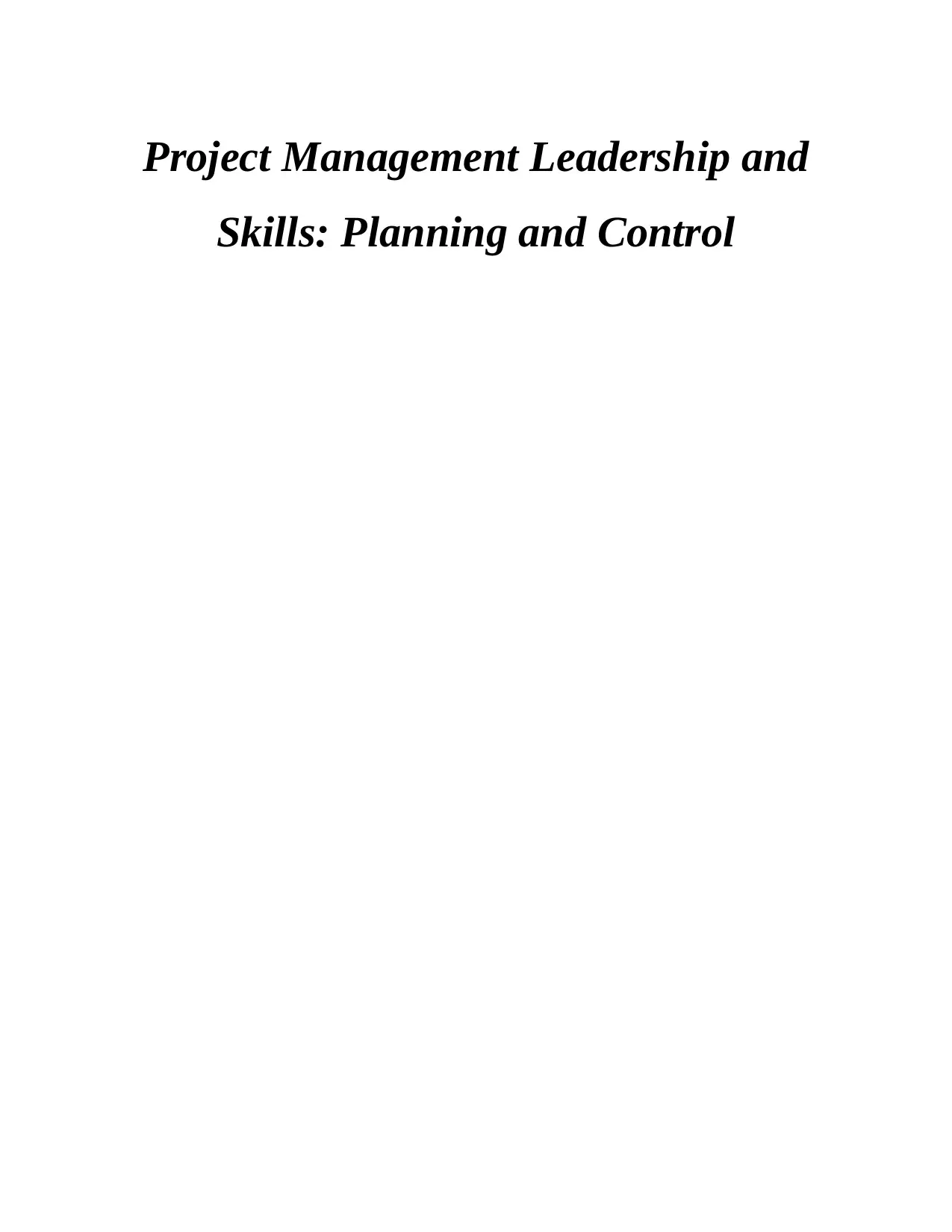
Project Management Leadership and
Skills: Planning and Control
Skills: Planning and Control
Paraphrase This Document
Need a fresh take? Get an instant paraphrase of this document with our AI Paraphraser
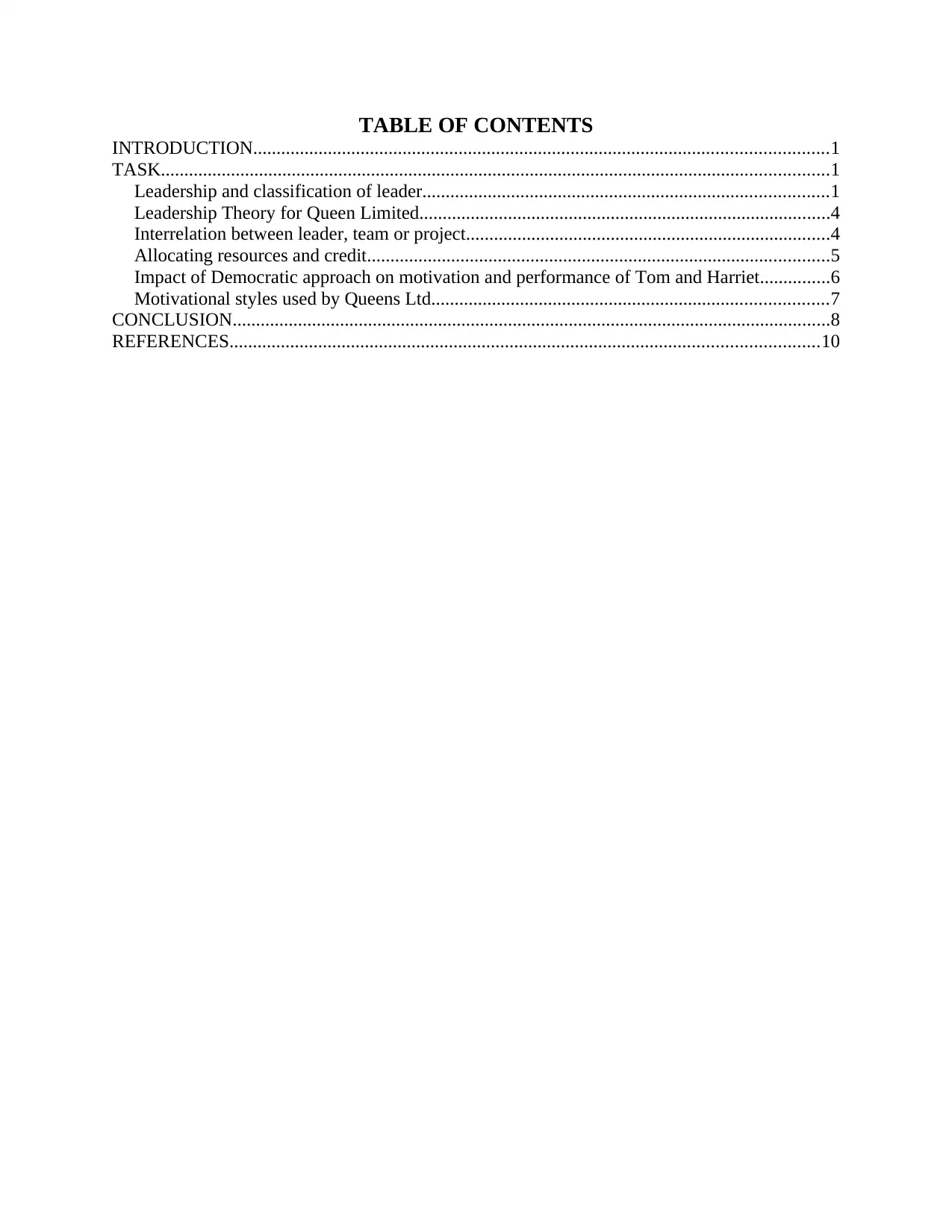
TABLE OF CONTENTS
INTRODUCTION...........................................................................................................................1
TASK...............................................................................................................................................1
Leadership and classification of leader.......................................................................................1
Leadership Theory for Queen Limited........................................................................................4
Interrelation between leader, team or project..............................................................................4
Allocating resources and credit...................................................................................................5
Impact of Democratic approach on motivation and performance of Tom and Harriet...............6
Motivational styles used by Queens Ltd.....................................................................................7
CONCLUSION................................................................................................................................8
REFERENCES..............................................................................................................................10
INTRODUCTION...........................................................................................................................1
TASK...............................................................................................................................................1
Leadership and classification of leader.......................................................................................1
Leadership Theory for Queen Limited........................................................................................4
Interrelation between leader, team or project..............................................................................4
Allocating resources and credit...................................................................................................5
Impact of Democratic approach on motivation and performance of Tom and Harriet...............6
Motivational styles used by Queens Ltd.....................................................................................7
CONCLUSION................................................................................................................................8
REFERENCES..............................................................................................................................10

ABSTRACT
This is fundamental to have proper motivation and guidance to the workers or individual
for achieving success which they gain through proper leading and purpose allotment. This is
required to have a good leader for a company to access to the world along with their entire
group. For it, this is necessary to understand various types of leader and leadership styles which
this report discuss about. It is significant to analyse the motivation methods & styles and sources
through which the business worker can get inspiration in proper way. This report evaluate those
aspects of planning and controlling of leadership skills.
INTRODUCTION
Motivation refer to inspiration which an individual or employee required for performing
more effectively (Hanisch and Wald, 2011). This can be through communication or rewarding
activities which help in inspiring and refreshing their activities and mood for better productivity.
For the management of team and staff, company organises the level of motivation and leadership
style to properly manage entire operations. This report will analyse the theory of leadership in
Fashion Enter that is one of the emerging and developing textile company render cloths and
apparel in United Kingdom nationwide. The purpose of this report is to analyse the leadership
style and relationship between leader and team. The report will argue the facts and style through
which they can motivate their worker. Also it will evaluate need of motivation along with their
role in company for resolving issues.
TASK
Leadership and classification of leaders
Leadership is ability of influencing teams, individuals or group of people. It is the
process through which individual directs and lead the entire staff or people through providing
them reason or purpose to work. This is the ability to manage staff in order to induce workers or
subordinates for realising the objectives and goals (Kerzner, 2013). A leader need to evolve the
vision, and motivate the future objectives for stimulating morals, confidence and values of
employee to achieving aims.
According to Keith Davis, “It is the ability to persuade others in finding the determined
objectives enthusiastically.” This is the factor which binds a human to engage the same work and
provide hope of growth.
1
This is fundamental to have proper motivation and guidance to the workers or individual
for achieving success which they gain through proper leading and purpose allotment. This is
required to have a good leader for a company to access to the world along with their entire
group. For it, this is necessary to understand various types of leader and leadership styles which
this report discuss about. It is significant to analyse the motivation methods & styles and sources
through which the business worker can get inspiration in proper way. This report evaluate those
aspects of planning and controlling of leadership skills.
INTRODUCTION
Motivation refer to inspiration which an individual or employee required for performing
more effectively (Hanisch and Wald, 2011). This can be through communication or rewarding
activities which help in inspiring and refreshing their activities and mood for better productivity.
For the management of team and staff, company organises the level of motivation and leadership
style to properly manage entire operations. This report will analyse the theory of leadership in
Fashion Enter that is one of the emerging and developing textile company render cloths and
apparel in United Kingdom nationwide. The purpose of this report is to analyse the leadership
style and relationship between leader and team. The report will argue the facts and style through
which they can motivate their worker. Also it will evaluate need of motivation along with their
role in company for resolving issues.
TASK
Leadership and classification of leaders
Leadership is ability of influencing teams, individuals or group of people. It is the
process through which individual directs and lead the entire staff or people through providing
them reason or purpose to work. This is the ability to manage staff in order to induce workers or
subordinates for realising the objectives and goals (Kerzner, 2013). A leader need to evolve the
vision, and motivate the future objectives for stimulating morals, confidence and values of
employee to achieving aims.
According to Keith Davis, “It is the ability to persuade others in finding the determined
objectives enthusiastically.” This is the factor which binds a human to engage the same work and
provide hope of growth.
1
⊘ This is a preview!⊘
Do you want full access?
Subscribe today to unlock all pages.

Trusted by 1+ million students worldwide
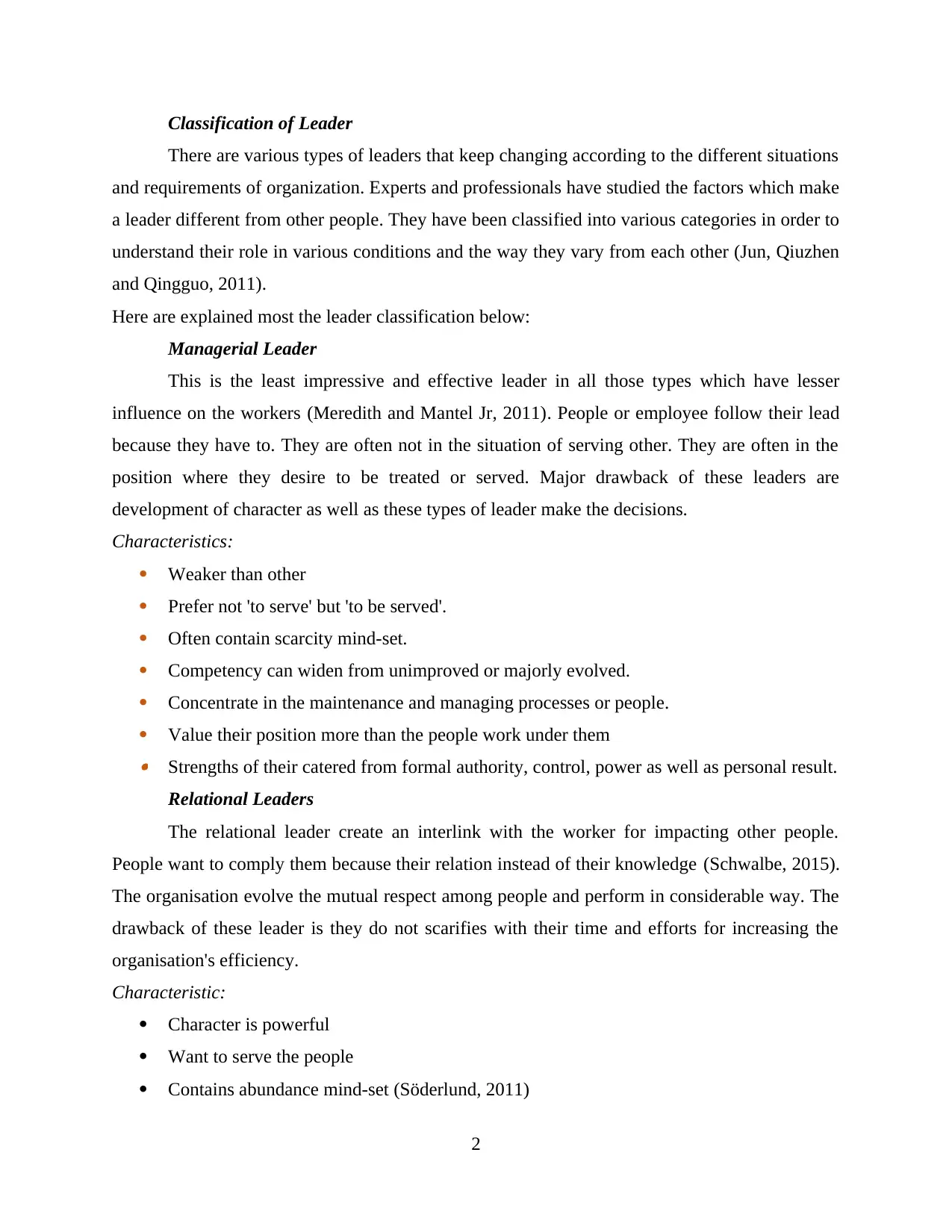
Classification of Leader
There are various types of leaders that keep changing according to the different situations
and requirements of organization. Experts and professionals have studied the factors which make
a leader different from other people. They have been classified into various categories in order to
understand their role in various conditions and the way they vary from each other (Jun, Qiuzhen
and Qingguo, 2011).
Here are explained most the leader classification below:
Managerial Leader
This is the least impressive and effective leader in all those types which have lesser
influence on the workers (Meredith and Mantel Jr, 2011). People or employee follow their lead
because they have to. They are often not in the situation of serving other. They are often in the
position where they desire to be treated or served. Major drawback of these leaders are
development of character as well as these types of leader make the decisions.
Characteristics:
Weaker than other
Prefer not 'to serve' but 'to be served'.
Often contain scarcity mind-set.
Competency can widen from unimproved or majorly evolved.
Concentrate in the maintenance and managing processes or people.
Value their position more than the people work under them Strengths of their catered from formal authority, control, power as well as personal result.
Relational Leaders
The relational leader create an interlink with the worker for impacting other people.
People want to comply them because their relation instead of their knowledge (Schwalbe, 2015).
The organisation evolve the mutual respect among people and perform in considerable way. The
drawback of these leader is they do not scarifies with their time and efforts for increasing the
organisation's efficiency.
Characteristic:
Character is powerful
Want to serve the people
Contains abundance mind-set (Söderlund, 2011)
2
There are various types of leaders that keep changing according to the different situations
and requirements of organization. Experts and professionals have studied the factors which make
a leader different from other people. They have been classified into various categories in order to
understand their role in various conditions and the way they vary from each other (Jun, Qiuzhen
and Qingguo, 2011).
Here are explained most the leader classification below:
Managerial Leader
This is the least impressive and effective leader in all those types which have lesser
influence on the workers (Meredith and Mantel Jr, 2011). People or employee follow their lead
because they have to. They are often not in the situation of serving other. They are often in the
position where they desire to be treated or served. Major drawback of these leaders are
development of character as well as these types of leader make the decisions.
Characteristics:
Weaker than other
Prefer not 'to serve' but 'to be served'.
Often contain scarcity mind-set.
Competency can widen from unimproved or majorly evolved.
Concentrate in the maintenance and managing processes or people.
Value their position more than the people work under them Strengths of their catered from formal authority, control, power as well as personal result.
Relational Leaders
The relational leader create an interlink with the worker for impacting other people.
People want to comply them because their relation instead of their knowledge (Schwalbe, 2015).
The organisation evolve the mutual respect among people and perform in considerable way. The
drawback of these leader is they do not scarifies with their time and efforts for increasing the
organisation's efficiency.
Characteristic:
Character is powerful
Want to serve the people
Contains abundance mind-set (Söderlund, 2011)
2
Paraphrase This Document
Need a fresh take? Get an instant paraphrase of this document with our AI Paraphraser
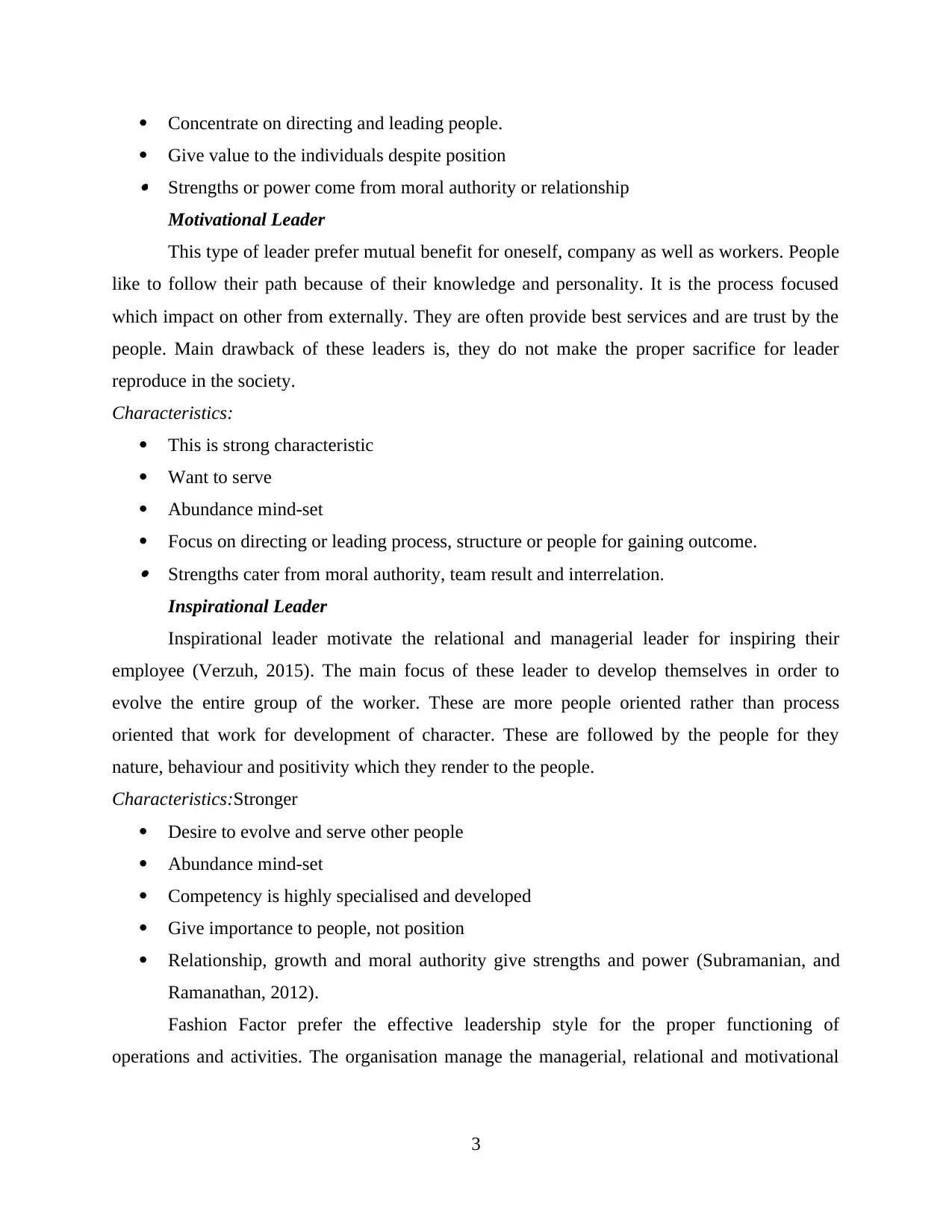
Concentrate on directing and leading people.
Give value to the individuals despite position Strengths or power come from moral authority or relationship
Motivational Leader
This type of leader prefer mutual benefit for oneself, company as well as workers. People
like to follow their path because of their knowledge and personality. It is the process focused
which impact on other from externally. They are often provide best services and are trust by the
people. Main drawback of these leaders is, they do not make the proper sacrifice for leader
reproduce in the society.
Characteristics:
This is strong characteristic
Want to serve
Abundance mind-set
Focus on directing or leading process, structure or people for gaining outcome. Strengths cater from moral authority, team result and interrelation.
Inspirational Leader
Inspirational leader motivate the relational and managerial leader for inspiring their
employee (Verzuh, 2015). The main focus of these leader to develop themselves in order to
evolve the entire group of the worker. These are more people oriented rather than process
oriented that work for development of character. These are followed by the people for they
nature, behaviour and positivity which they render to the people.
Characteristics:Stronger
Desire to evolve and serve other people
Abundance mind-set
Competency is highly specialised and developed
Give importance to people, not position
Relationship, growth and moral authority give strengths and power (Subramanian, and
Ramanathan, 2012).
Fashion Factor prefer the effective leadership style for the proper functioning of
operations and activities. The organisation manage the managerial, relational and motivational
3
Give value to the individuals despite position Strengths or power come from moral authority or relationship
Motivational Leader
This type of leader prefer mutual benefit for oneself, company as well as workers. People
like to follow their path because of their knowledge and personality. It is the process focused
which impact on other from externally. They are often provide best services and are trust by the
people. Main drawback of these leaders is, they do not make the proper sacrifice for leader
reproduce in the society.
Characteristics:
This is strong characteristic
Want to serve
Abundance mind-set
Focus on directing or leading process, structure or people for gaining outcome. Strengths cater from moral authority, team result and interrelation.
Inspirational Leader
Inspirational leader motivate the relational and managerial leader for inspiring their
employee (Verzuh, 2015). The main focus of these leader to develop themselves in order to
evolve the entire group of the worker. These are more people oriented rather than process
oriented that work for development of character. These are followed by the people for they
nature, behaviour and positivity which they render to the people.
Characteristics:Stronger
Desire to evolve and serve other people
Abundance mind-set
Competency is highly specialised and developed
Give importance to people, not position
Relationship, growth and moral authority give strengths and power (Subramanian, and
Ramanathan, 2012).
Fashion Factor prefer the effective leadership style for the proper functioning of
operations and activities. The organisation manage the managerial, relational and motivational
3
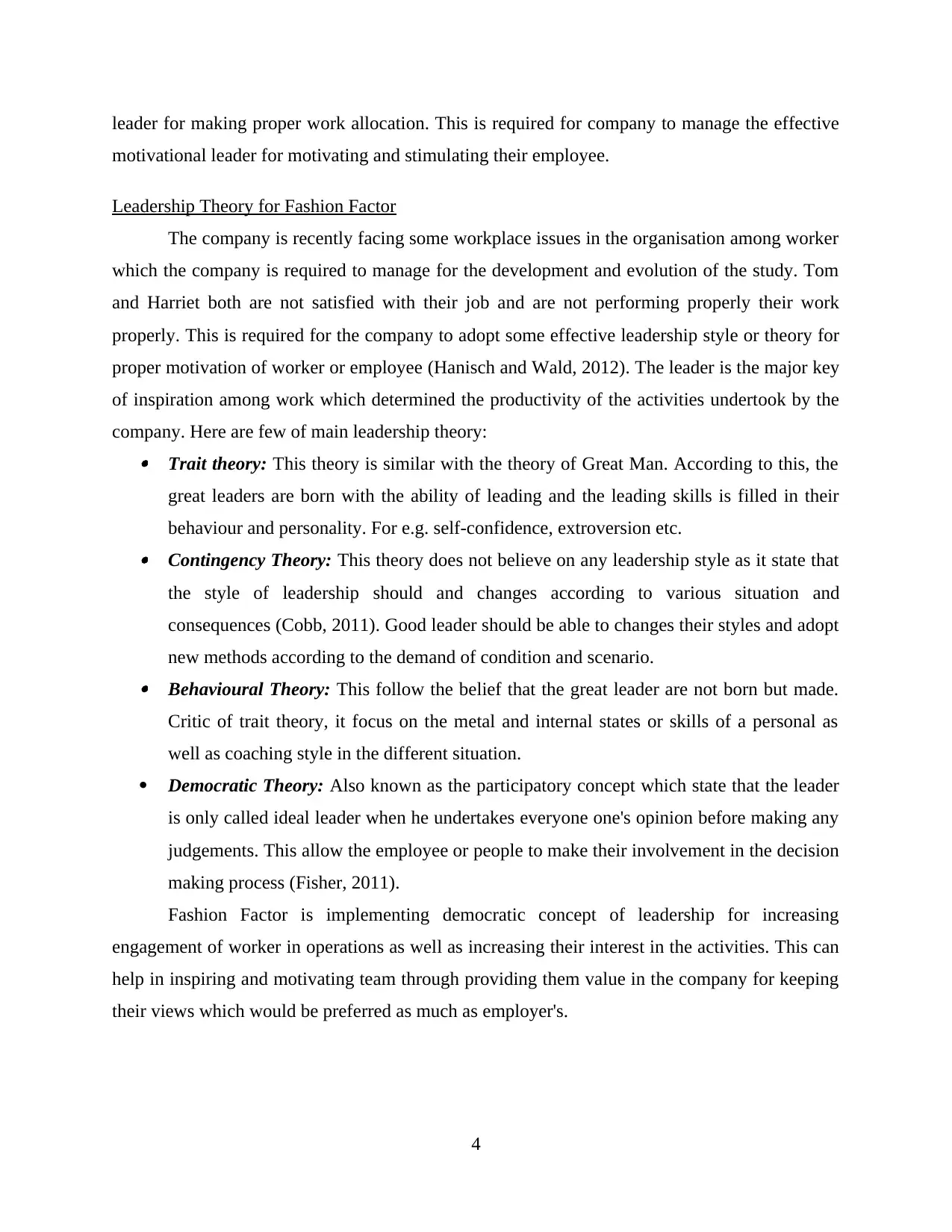
leader for making proper work allocation. This is required for company to manage the effective
motivational leader for motivating and stimulating their employee.
Leadership Theory for Fashion Factor
The company is recently facing some workplace issues in the organisation among worker
which the company is required to manage for the development and evolution of the study. Tom
and Harriet both are not satisfied with their job and are not performing properly their work
properly. This is required for the company to adopt some effective leadership style or theory for
proper motivation of worker or employee (Hanisch and Wald, 2012). The leader is the major key
of inspiration among work which determined the productivity of the activities undertook by the
company. Here are few of main leadership theory: Trait theory: This theory is similar with the theory of Great Man. According to this, the
great leaders are born with the ability of leading and the leading skills is filled in their
behaviour and personality. For e.g. self-confidence, extroversion etc. Contingency Theory: This theory does not believe on any leadership style as it state that
the style of leadership should and changes according to various situation and
consequences (Cobb, 2011). Good leader should be able to changes their styles and adopt
new methods according to the demand of condition and scenario. Behavioural Theory: This follow the belief that the great leader are not born but made.
Critic of trait theory, it focus on the metal and internal states or skills of a personal as
well as coaching style in the different situation.
Democratic Theory: Also known as the participatory concept which state that the leader
is only called ideal leader when he undertakes everyone one's opinion before making any
judgements. This allow the employee or people to make their involvement in the decision
making process (Fisher, 2011).
Fashion Factor is implementing democratic concept of leadership for increasing
engagement of worker in operations as well as increasing their interest in the activities. This can
help in inspiring and motivating team through providing them value in the company for keeping
their views which would be preferred as much as employer's.
4
motivational leader for motivating and stimulating their employee.
Leadership Theory for Fashion Factor
The company is recently facing some workplace issues in the organisation among worker
which the company is required to manage for the development and evolution of the study. Tom
and Harriet both are not satisfied with their job and are not performing properly their work
properly. This is required for the company to adopt some effective leadership style or theory for
proper motivation of worker or employee (Hanisch and Wald, 2012). The leader is the major key
of inspiration among work which determined the productivity of the activities undertook by the
company. Here are few of main leadership theory: Trait theory: This theory is similar with the theory of Great Man. According to this, the
great leaders are born with the ability of leading and the leading skills is filled in their
behaviour and personality. For e.g. self-confidence, extroversion etc. Contingency Theory: This theory does not believe on any leadership style as it state that
the style of leadership should and changes according to various situation and
consequences (Cobb, 2011). Good leader should be able to changes their styles and adopt
new methods according to the demand of condition and scenario. Behavioural Theory: This follow the belief that the great leader are not born but made.
Critic of trait theory, it focus on the metal and internal states or skills of a personal as
well as coaching style in the different situation.
Democratic Theory: Also known as the participatory concept which state that the leader
is only called ideal leader when he undertakes everyone one's opinion before making any
judgements. This allow the employee or people to make their involvement in the decision
making process (Fisher, 2011).
Fashion Factor is implementing democratic concept of leadership for increasing
engagement of worker in operations as well as increasing their interest in the activities. This can
help in inspiring and motivating team through providing them value in the company for keeping
their views which would be preferred as much as employer's.
4
⊘ This is a preview!⊘
Do you want full access?
Subscribe today to unlock all pages.

Trusted by 1+ million students worldwide

Interrelation between leader, team or project
Leader is the individual who is responsible for determining design, plan and strategies of
Fashion Factor for making projects implementation, they are the person who determined the
project for achieving a specific goals or mission.
Project is the activity or plan which is designed by the leader to make a specific changes
in system or activity to be executed in the company. Whereas team refer to group of employee
which have been bonded or catered together in order to accomplish a specific target.
These three bodies are interrelated each other for completion the entire process. Project is
designed by the leader for reaching to the vision and set purpose (Hwang and Ng, 2013). For
which the leader require a proper team work in order to meet those goals in most effective
manner. This is the responsibility of leader to make the rights decision and rights project for
development that can only be executed in the entity through the help of well-built team, hence,
they are interlinked with each other for success (Doloi, 2012).
Allocating resources and credit
There are certain types of sources which are very important and essential for the
managers as well as their employees. In the case scenario, both are not play their role and
responsibility regarding business success and growth. In this situation, business organisation
should try to apply motivational and leadership theory because both are beneficial in order to
promote and motivate towards its jobs and workers.
Motivational style: It is one of the essential and valuable part of manger and their
workers with regard to encourage their staff members. Fashion Factor is a clothing organisation
in United Kingdom which is mainly deal with girl’s clothes. In this business can give incentives,
extra benefits, bonus, rewards, fair remunerations, compensations and other benefits. They can
also try to give better training and development section for both persons, so that they can attend
this programs and increase their basic knowledge and skills. Motivated people can achieve the
higher productivity and profitability of the company effectively. Firm can understand their
employers and employee’s basic needs and requirement with the help of these they can easily
attain there long as well as desire goals and objectives.
Leadership styles: Fashion Factor can also adopt the democratic leadership style which
enables their co-worker to perform effectively and efficiently towards achieving organisational
goal. Leader is the one who extract best from their followers, hence increasing overall
5
Leader is the individual who is responsible for determining design, plan and strategies of
Fashion Factor for making projects implementation, they are the person who determined the
project for achieving a specific goals or mission.
Project is the activity or plan which is designed by the leader to make a specific changes
in system or activity to be executed in the company. Whereas team refer to group of employee
which have been bonded or catered together in order to accomplish a specific target.
These three bodies are interrelated each other for completion the entire process. Project is
designed by the leader for reaching to the vision and set purpose (Hwang and Ng, 2013). For
which the leader require a proper team work in order to meet those goals in most effective
manner. This is the responsibility of leader to make the rights decision and rights project for
development that can only be executed in the entity through the help of well-built team, hence,
they are interlinked with each other for success (Doloi, 2012).
Allocating resources and credit
There are certain types of sources which are very important and essential for the
managers as well as their employees. In the case scenario, both are not play their role and
responsibility regarding business success and growth. In this situation, business organisation
should try to apply motivational and leadership theory because both are beneficial in order to
promote and motivate towards its jobs and workers.
Motivational style: It is one of the essential and valuable part of manger and their
workers with regard to encourage their staff members. Fashion Factor is a clothing organisation
in United Kingdom which is mainly deal with girl’s clothes. In this business can give incentives,
extra benefits, bonus, rewards, fair remunerations, compensations and other benefits. They can
also try to give better training and development section for both persons, so that they can attend
this programs and increase their basic knowledge and skills. Motivated people can achieve the
higher productivity and profitability of the company effectively. Firm can understand their
employers and employee’s basic needs and requirement with the help of these they can easily
attain there long as well as desire goals and objectives.
Leadership styles: Fashion Factor can also adopt the democratic leadership style which
enables their co-worker to perform effectively and efficiently towards achieving organisational
goal. Leader is the one who extract best from their followers, hence increasing overall
5
Paraphrase This Document
Need a fresh take? Get an instant paraphrase of this document with our AI Paraphraser
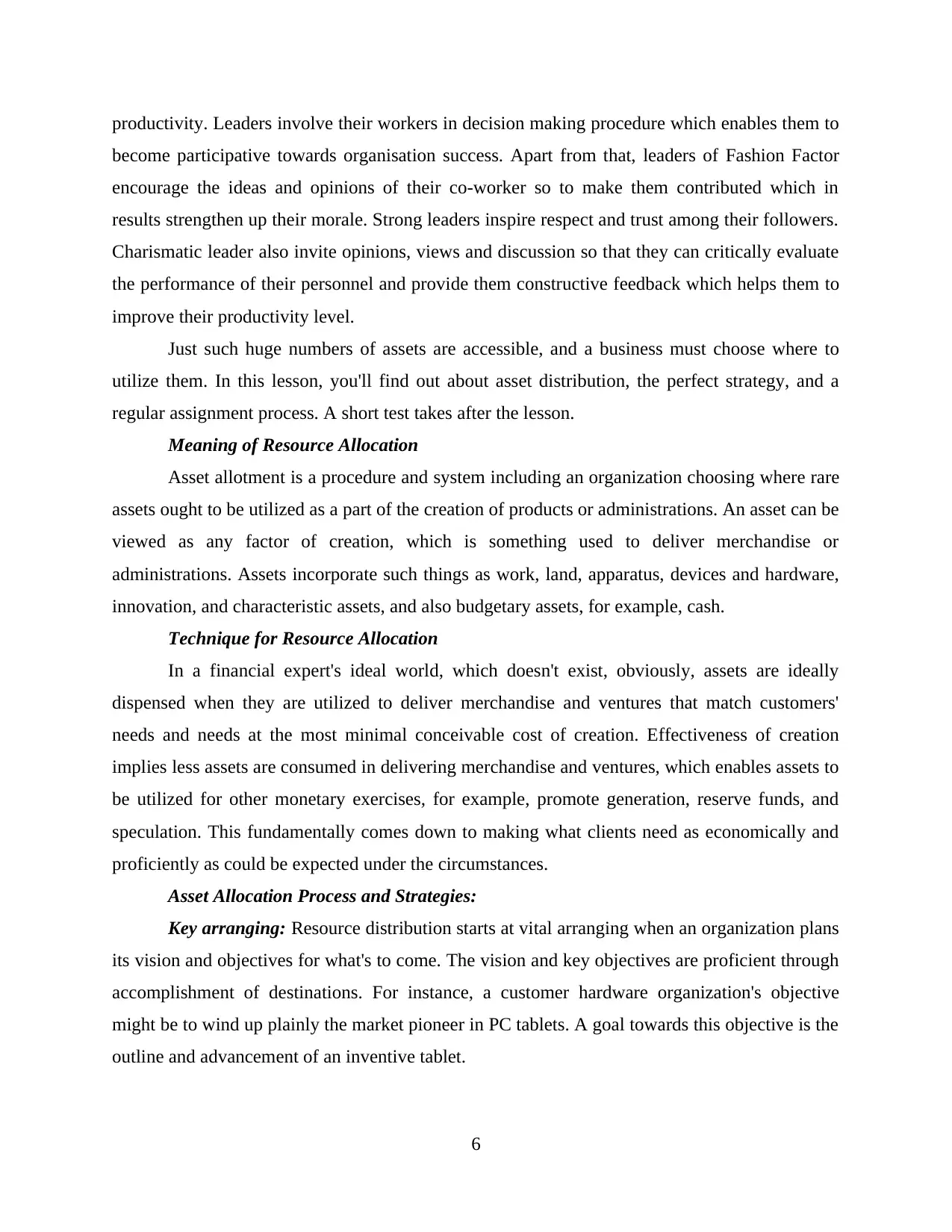
productivity. Leaders involve their workers in decision making procedure which enables them to
become participative towards organisation success. Apart from that, leaders of Fashion Factor
encourage the ideas and opinions of their co-worker so to make them contributed which in
results strengthen up their morale. Strong leaders inspire respect and trust among their followers.
Charismatic leader also invite opinions, views and discussion so that they can critically evaluate
the performance of their personnel and provide them constructive feedback which helps them to
improve their productivity level.
Just such huge numbers of assets are accessible, and a business must choose where to
utilize them. In this lesson, you'll find out about asset distribution, the perfect strategy, and a
regular assignment process. A short test takes after the lesson.
Meaning of Resource Allocation
Asset allotment is a procedure and system including an organization choosing where rare
assets ought to be utilized as a part of the creation of products or administrations. An asset can be
viewed as any factor of creation, which is something used to deliver merchandise or
administrations. Assets incorporate such things as work, land, apparatus, devices and hardware,
innovation, and characteristic assets, and also budgetary assets, for example, cash.
Technique for Resource Allocation
In a financial expert's ideal world, which doesn't exist, obviously, assets are ideally
dispensed when they are utilized to deliver merchandise and ventures that match customers'
needs and needs at the most minimal conceivable cost of creation. Effectiveness of creation
implies less assets are consumed in delivering merchandise and ventures, which enables assets to
be utilized for other monetary exercises, for example, promote generation, reserve funds, and
speculation. This fundamentally comes down to making what clients need as economically and
proficiently as could be expected under the circumstances.
Asset Allocation Process and Strategies:
Key arranging: Resource distribution starts at vital arranging when an organization plans
its vision and objectives for what's to come. The vision and key objectives are proficient through
accomplishment of destinations. For instance, a customer hardware organization's objective
might be to wind up plainly the market pioneer in PC tablets. A goal towards this objective is the
outline and advancement of an inventive tablet.
6
become participative towards organisation success. Apart from that, leaders of Fashion Factor
encourage the ideas and opinions of their co-worker so to make them contributed which in
results strengthen up their morale. Strong leaders inspire respect and trust among their followers.
Charismatic leader also invite opinions, views and discussion so that they can critically evaluate
the performance of their personnel and provide them constructive feedback which helps them to
improve their productivity level.
Just such huge numbers of assets are accessible, and a business must choose where to
utilize them. In this lesson, you'll find out about asset distribution, the perfect strategy, and a
regular assignment process. A short test takes after the lesson.
Meaning of Resource Allocation
Asset allotment is a procedure and system including an organization choosing where rare
assets ought to be utilized as a part of the creation of products or administrations. An asset can be
viewed as any factor of creation, which is something used to deliver merchandise or
administrations. Assets incorporate such things as work, land, apparatus, devices and hardware,
innovation, and characteristic assets, and also budgetary assets, for example, cash.
Technique for Resource Allocation
In a financial expert's ideal world, which doesn't exist, obviously, assets are ideally
dispensed when they are utilized to deliver merchandise and ventures that match customers'
needs and needs at the most minimal conceivable cost of creation. Effectiveness of creation
implies less assets are consumed in delivering merchandise and ventures, which enables assets to
be utilized for other monetary exercises, for example, promote generation, reserve funds, and
speculation. This fundamentally comes down to making what clients need as economically and
proficiently as could be expected under the circumstances.
Asset Allocation Process and Strategies:
Key arranging: Resource distribution starts at vital arranging when an organization plans
its vision and objectives for what's to come. The vision and key objectives are proficient through
accomplishment of destinations. For instance, a customer hardware organization's objective
might be to wind up plainly the market pioneer in PC tablets. A goal towards this objective is the
outline and advancement of an inventive tablet.
6
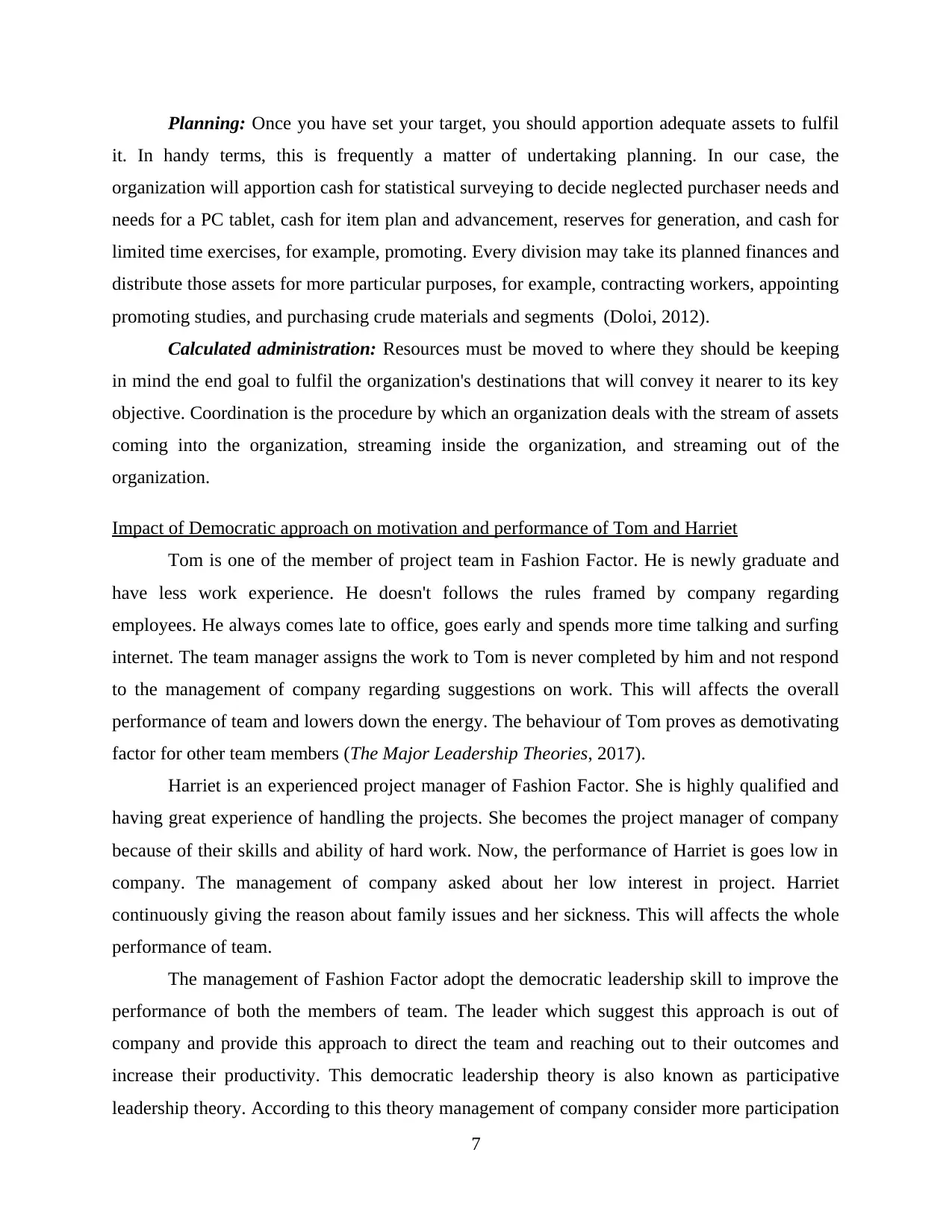
Planning: Once you have set your target, you should apportion adequate assets to fulfil
it. In handy terms, this is frequently a matter of undertaking planning. In our case, the
organization will apportion cash for statistical surveying to decide neglected purchaser needs and
needs for a PC tablet, cash for item plan and advancement, reserves for generation, and cash for
limited time exercises, for example, promoting. Every division may take its planned finances and
distribute those assets for more particular purposes, for example, contracting workers, appointing
promoting studies, and purchasing crude materials and segments (Doloi, 2012).
Calculated administration: Resources must be moved to where they should be keeping
in mind the end goal to fulfil the organization's destinations that will convey it nearer to its key
objective. Coordination is the procedure by which an organization deals with the stream of assets
coming into the organization, streaming inside the organization, and streaming out of the
organization.
Impact of Democratic approach on motivation and performance of Tom and Harriet
Tom is one of the member of project team in Fashion Factor. He is newly graduate and
have less work experience. He doesn't follows the rules framed by company regarding
employees. He always comes late to office, goes early and spends more time talking and surfing
internet. The team manager assigns the work to Tom is never completed by him and not respond
to the management of company regarding suggestions on work. This will affects the overall
performance of team and lowers down the energy. The behaviour of Tom proves as demotivating
factor for other team members (The Major Leadership Theories, 2017).
Harriet is an experienced project manager of Fashion Factor. She is highly qualified and
having great experience of handling the projects. She becomes the project manager of company
because of their skills and ability of hard work. Now, the performance of Harriet is goes low in
company. The management of company asked about her low interest in project. Harriet
continuously giving the reason about family issues and her sickness. This will affects the whole
performance of team.
The management of Fashion Factor adopt the democratic leadership skill to improve the
performance of both the members of team. The leader which suggest this approach is out of
company and provide this approach to direct the team and reaching out to their outcomes and
increase their productivity. This democratic leadership theory is also known as participative
leadership theory. According to this theory management of company consider more participation
7
it. In handy terms, this is frequently a matter of undertaking planning. In our case, the
organization will apportion cash for statistical surveying to decide neglected purchaser needs and
needs for a PC tablet, cash for item plan and advancement, reserves for generation, and cash for
limited time exercises, for example, promoting. Every division may take its planned finances and
distribute those assets for more particular purposes, for example, contracting workers, appointing
promoting studies, and purchasing crude materials and segments (Doloi, 2012).
Calculated administration: Resources must be moved to where they should be keeping
in mind the end goal to fulfil the organization's destinations that will convey it nearer to its key
objective. Coordination is the procedure by which an organization deals with the stream of assets
coming into the organization, streaming inside the organization, and streaming out of the
organization.
Impact of Democratic approach on motivation and performance of Tom and Harriet
Tom is one of the member of project team in Fashion Factor. He is newly graduate and
have less work experience. He doesn't follows the rules framed by company regarding
employees. He always comes late to office, goes early and spends more time talking and surfing
internet. The team manager assigns the work to Tom is never completed by him and not respond
to the management of company regarding suggestions on work. This will affects the overall
performance of team and lowers down the energy. The behaviour of Tom proves as demotivating
factor for other team members (The Major Leadership Theories, 2017).
Harriet is an experienced project manager of Fashion Factor. She is highly qualified and
having great experience of handling the projects. She becomes the project manager of company
because of their skills and ability of hard work. Now, the performance of Harriet is goes low in
company. The management of company asked about her low interest in project. Harriet
continuously giving the reason about family issues and her sickness. This will affects the whole
performance of team.
The management of Fashion Factor adopt the democratic leadership skill to improve the
performance of both the members of team. The leader which suggest this approach is out of
company and provide this approach to direct the team and reaching out to their outcomes and
increase their productivity. This democratic leadership theory is also known as participative
leadership theory. According to this theory management of company consider more participation
7
⊘ This is a preview!⊘
Do you want full access?
Subscribe today to unlock all pages.

Trusted by 1+ million students worldwide
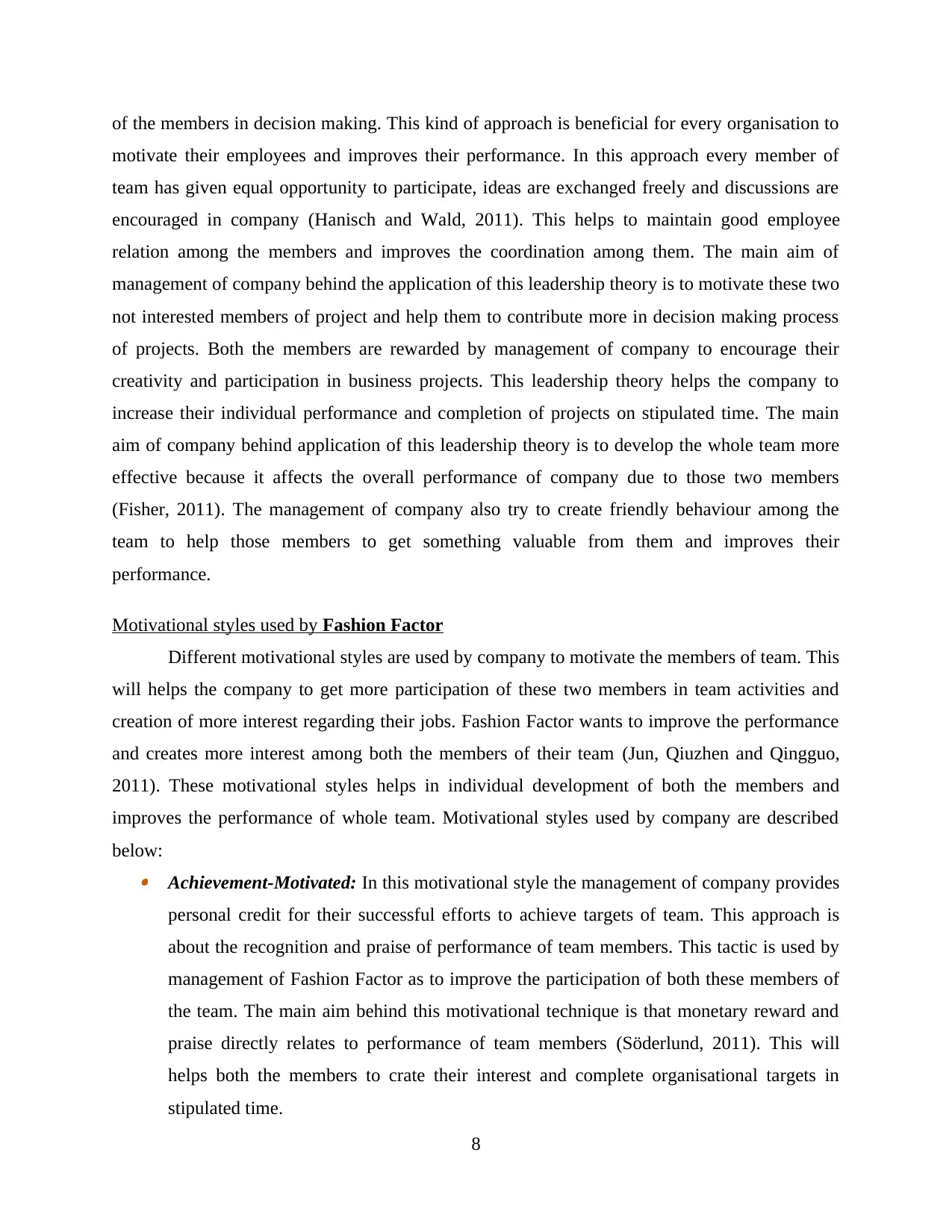
of the members in decision making. This kind of approach is beneficial for every organisation to
motivate their employees and improves their performance. In this approach every member of
team has given equal opportunity to participate, ideas are exchanged freely and discussions are
encouraged in company (Hanisch and Wald, 2011). This helps to maintain good employee
relation among the members and improves the coordination among them. The main aim of
management of company behind the application of this leadership theory is to motivate these two
not interested members of project and help them to contribute more in decision making process
of projects. Both the members are rewarded by management of company to encourage their
creativity and participation in business projects. This leadership theory helps the company to
increase their individual performance and completion of projects on stipulated time. The main
aim of company behind application of this leadership theory is to develop the whole team more
effective because it affects the overall performance of company due to those two members
(Fisher, 2011). The management of company also try to create friendly behaviour among the
team to help those members to get something valuable from them and improves their
performance.
Motivational styles used by Fashion Factor
Different motivational styles are used by company to motivate the members of team. This
will helps the company to get more participation of these two members in team activities and
creation of more interest regarding their jobs. Fashion Factor wants to improve the performance
and creates more interest among both the members of their team (Jun, Qiuzhen and Qingguo,
2011). These motivational styles helps in individual development of both the members and
improves the performance of whole team. Motivational styles used by company are described
below: Achievement-Motivated: In this motivational style the management of company provides
personal credit for their successful efforts to achieve targets of team. This approach is
about the recognition and praise of performance of team members. This tactic is used by
management of Fashion Factor as to improve the participation of both these members of
the team. The main aim behind this motivational technique is that monetary reward and
praise directly relates to performance of team members (Söderlund, 2011). This will
helps both the members to crate their interest and complete organisational targets in
stipulated time.
8
motivate their employees and improves their performance. In this approach every member of
team has given equal opportunity to participate, ideas are exchanged freely and discussions are
encouraged in company (Hanisch and Wald, 2011). This helps to maintain good employee
relation among the members and improves the coordination among them. The main aim of
management of company behind the application of this leadership theory is to motivate these two
not interested members of project and help them to contribute more in decision making process
of projects. Both the members are rewarded by management of company to encourage their
creativity and participation in business projects. This leadership theory helps the company to
increase their individual performance and completion of projects on stipulated time. The main
aim of company behind application of this leadership theory is to develop the whole team more
effective because it affects the overall performance of company due to those two members
(Fisher, 2011). The management of company also try to create friendly behaviour among the
team to help those members to get something valuable from them and improves their
performance.
Motivational styles used by Fashion Factor
Different motivational styles are used by company to motivate the members of team. This
will helps the company to get more participation of these two members in team activities and
creation of more interest regarding their jobs. Fashion Factor wants to improve the performance
and creates more interest among both the members of their team (Jun, Qiuzhen and Qingguo,
2011). These motivational styles helps in individual development of both the members and
improves the performance of whole team. Motivational styles used by company are described
below: Achievement-Motivated: In this motivational style the management of company provides
personal credit for their successful efforts to achieve targets of team. This approach is
about the recognition and praise of performance of team members. This tactic is used by
management of Fashion Factor as to improve the participation of both these members of
the team. The main aim behind this motivational technique is that monetary reward and
praise directly relates to performance of team members (Söderlund, 2011). This will
helps both the members to crate their interest and complete organisational targets in
stipulated time.
8
Paraphrase This Document
Need a fresh take? Get an instant paraphrase of this document with our AI Paraphraser
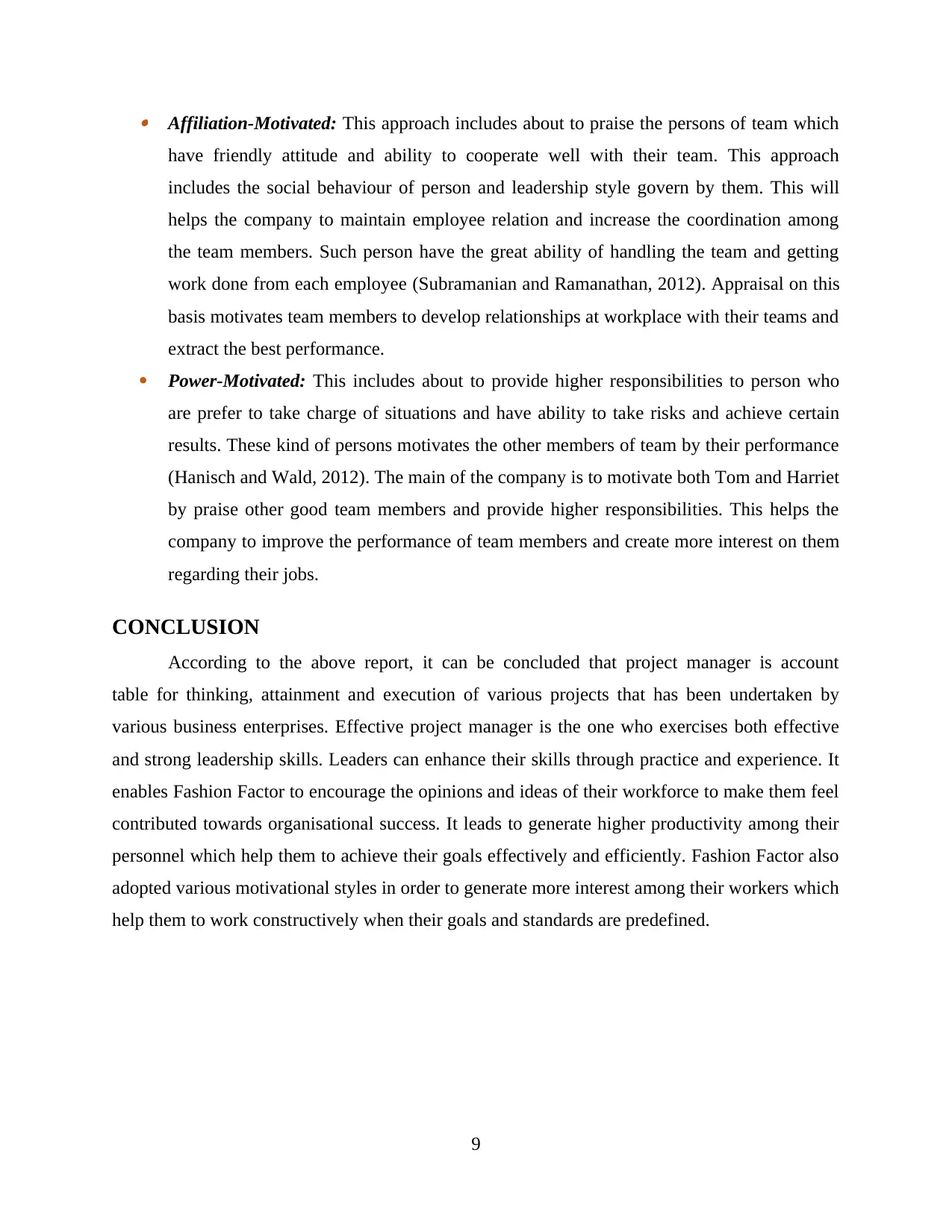
Affiliation-Motivated: This approach includes about to praise the persons of team which
have friendly attitude and ability to cooperate well with their team. This approach
includes the social behaviour of person and leadership style govern by them. This will
helps the company to maintain employee relation and increase the coordination among
the team members. Such person have the great ability of handling the team and getting
work done from each employee (Subramanian and Ramanathan, 2012). Appraisal on this
basis motivates team members to develop relationships at workplace with their teams and
extract the best performance.
Power-Motivated: This includes about to provide higher responsibilities to person who
are prefer to take charge of situations and have ability to take risks and achieve certain
results. These kind of persons motivates the other members of team by their performance
(Hanisch and Wald, 2012). The main of the company is to motivate both Tom and Harriet
by praise other good team members and provide higher responsibilities. This helps the
company to improve the performance of team members and create more interest on them
regarding their jobs.
CONCLUSION
According to the above report, it can be concluded that project manager is account
table for thinking, attainment and execution of various projects that has been undertaken by
various business enterprises. Effective project manager is the one who exercises both effective
and strong leadership skills. Leaders can enhance their skills through practice and experience. It
enables Fashion Factor to encourage the opinions and ideas of their workforce to make them feel
contributed towards organisational success. It leads to generate higher productivity among their
personnel which help them to achieve their goals effectively and efficiently. Fashion Factor also
adopted various motivational styles in order to generate more interest among their workers which
help them to work constructively when their goals and standards are predefined.
9
have friendly attitude and ability to cooperate well with their team. This approach
includes the social behaviour of person and leadership style govern by them. This will
helps the company to maintain employee relation and increase the coordination among
the team members. Such person have the great ability of handling the team and getting
work done from each employee (Subramanian and Ramanathan, 2012). Appraisal on this
basis motivates team members to develop relationships at workplace with their teams and
extract the best performance.
Power-Motivated: This includes about to provide higher responsibilities to person who
are prefer to take charge of situations and have ability to take risks and achieve certain
results. These kind of persons motivates the other members of team by their performance
(Hanisch and Wald, 2012). The main of the company is to motivate both Tom and Harriet
by praise other good team members and provide higher responsibilities. This helps the
company to improve the performance of team members and create more interest on them
regarding their jobs.
CONCLUSION
According to the above report, it can be concluded that project manager is account
table for thinking, attainment and execution of various projects that has been undertaken by
various business enterprises. Effective project manager is the one who exercises both effective
and strong leadership skills. Leaders can enhance their skills through practice and experience. It
enables Fashion Factor to encourage the opinions and ideas of their workforce to make them feel
contributed towards organisational success. It leads to generate higher productivity among their
personnel which help them to achieve their goals effectively and efficiently. Fashion Factor also
adopted various motivational styles in order to generate more interest among their workers which
help them to work constructively when their goals and standards are predefined.
9
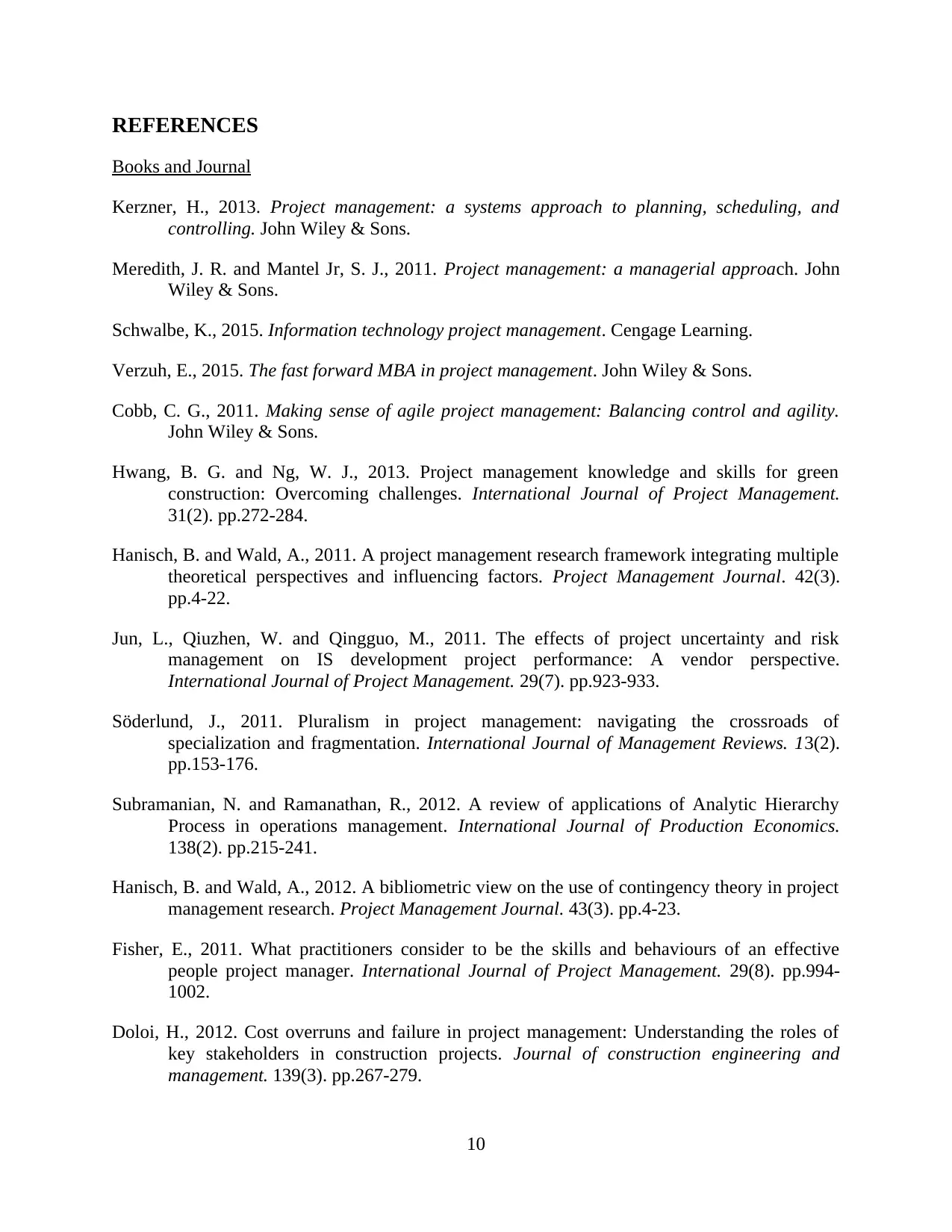
REFERENCES
Books and Journal
Kerzner, H., 2013. Project management: a systems approach to planning, scheduling, and
controlling. John Wiley & Sons.
Meredith, J. R. and Mantel Jr, S. J., 2011. Project management: a managerial approach. John
Wiley & Sons.
Schwalbe, K., 2015. Information technology project management. Cengage Learning.
Verzuh, E., 2015. The fast forward MBA in project management. John Wiley & Sons.
Cobb, C. G., 2011. Making sense of agile project management: Balancing control and agility.
John Wiley & Sons.
Hwang, B. G. and Ng, W. J., 2013. Project management knowledge and skills for green
construction: Overcoming challenges. International Journal of Project Management.
31(2). pp.272-284.
Hanisch, B. and Wald, A., 2011. A project management research framework integrating multiple
theoretical perspectives and influencing factors. Project Management Journal. 42(3).
pp.4-22.
Jun, L., Qiuzhen, W. and Qingguo, M., 2011. The effects of project uncertainty and risk
management on IS development project performance: A vendor perspective.
International Journal of Project Management. 29(7). pp.923-933.
Söderlund, J., 2011. Pluralism in project management: navigating the crossroads of
specialization and fragmentation. International Journal of Management Reviews. 13(2).
pp.153-176.
Subramanian, N. and Ramanathan, R., 2012. A review of applications of Analytic Hierarchy
Process in operations management. International Journal of Production Economics.
138(2). pp.215-241.
Hanisch, B. and Wald, A., 2012. A bibliometric view on the use of contingency theory in project
management research. Project Management Journal. 43(3). pp.4-23.
Fisher, E., 2011. What practitioners consider to be the skills and behaviours of an effective
people project manager. International Journal of Project Management. 29(8). pp.994-
1002.
Doloi, H., 2012. Cost overruns and failure in project management: Understanding the roles of
key stakeholders in construction projects. Journal of construction engineering and
management. 139(3). pp.267-279.
10
Books and Journal
Kerzner, H., 2013. Project management: a systems approach to planning, scheduling, and
controlling. John Wiley & Sons.
Meredith, J. R. and Mantel Jr, S. J., 2011. Project management: a managerial approach. John
Wiley & Sons.
Schwalbe, K., 2015. Information technology project management. Cengage Learning.
Verzuh, E., 2015. The fast forward MBA in project management. John Wiley & Sons.
Cobb, C. G., 2011. Making sense of agile project management: Balancing control and agility.
John Wiley & Sons.
Hwang, B. G. and Ng, W. J., 2013. Project management knowledge and skills for green
construction: Overcoming challenges. International Journal of Project Management.
31(2). pp.272-284.
Hanisch, B. and Wald, A., 2011. A project management research framework integrating multiple
theoretical perspectives and influencing factors. Project Management Journal. 42(3).
pp.4-22.
Jun, L., Qiuzhen, W. and Qingguo, M., 2011. The effects of project uncertainty and risk
management on IS development project performance: A vendor perspective.
International Journal of Project Management. 29(7). pp.923-933.
Söderlund, J., 2011. Pluralism in project management: navigating the crossroads of
specialization and fragmentation. International Journal of Management Reviews. 13(2).
pp.153-176.
Subramanian, N. and Ramanathan, R., 2012. A review of applications of Analytic Hierarchy
Process in operations management. International Journal of Production Economics.
138(2). pp.215-241.
Hanisch, B. and Wald, A., 2012. A bibliometric view on the use of contingency theory in project
management research. Project Management Journal. 43(3). pp.4-23.
Fisher, E., 2011. What practitioners consider to be the skills and behaviours of an effective
people project manager. International Journal of Project Management. 29(8). pp.994-
1002.
Doloi, H., 2012. Cost overruns and failure in project management: Understanding the roles of
key stakeholders in construction projects. Journal of construction engineering and
management. 139(3). pp.267-279.
10
⊘ This is a preview!⊘
Do you want full access?
Subscribe today to unlock all pages.

Trusted by 1+ million students worldwide
1 out of 13
Related Documents
Your All-in-One AI-Powered Toolkit for Academic Success.
+13062052269
info@desklib.com
Available 24*7 on WhatsApp / Email
![[object Object]](/_next/static/media/star-bottom.7253800d.svg)
Unlock your academic potential
Copyright © 2020–2025 A2Z Services. All Rights Reserved. Developed and managed by ZUCOL.





